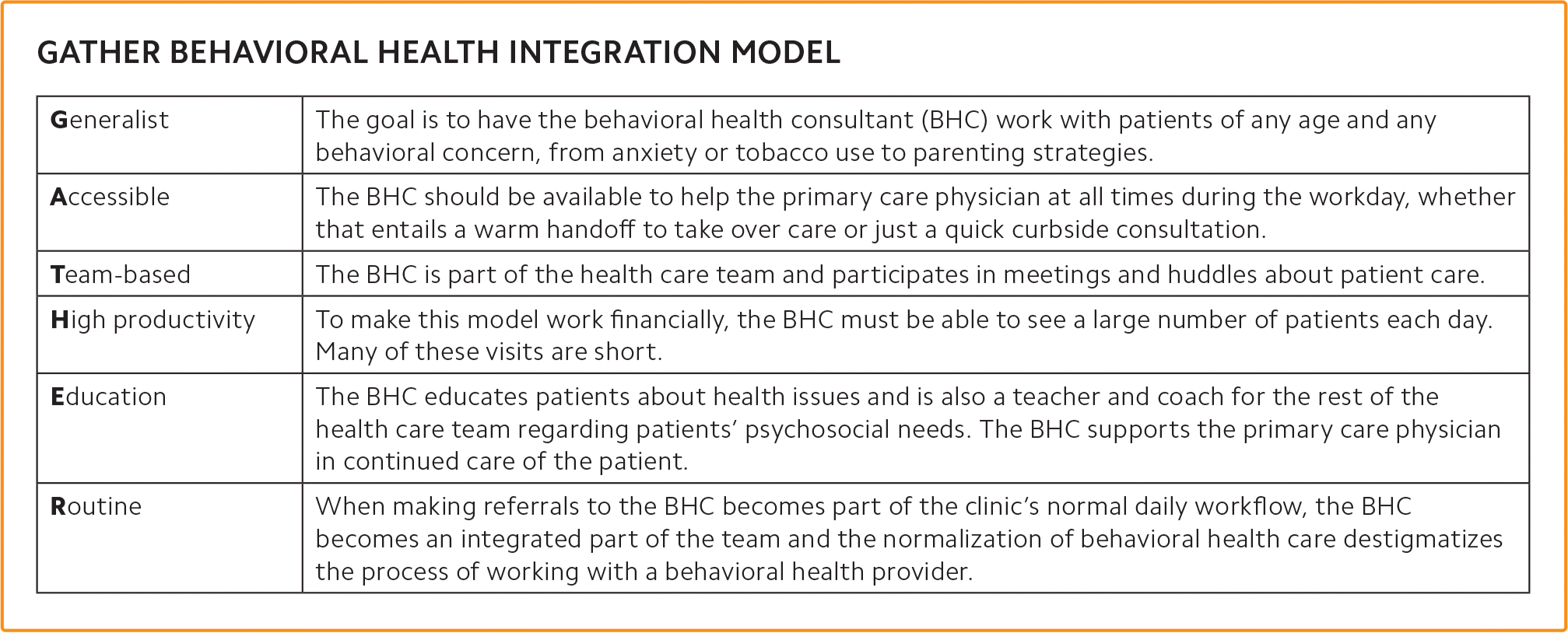
Integrating behavioral health improves patient outcomes and makes medical practice more satisfying. Here's one way to do it.
Fam Pract Manag. 2021;28(3):3-4
Up to 75% of primary care visits include mental or behavioral health components.1 This includes behavioral factors related to chronic disease management, mental health issues, substance use, smoking or other tobacco use, and the impact of stress, diet, and exercise on health. Behavioral health factors have an outsized influence on morbidity and mortality, and are the source of a large portion of family physicians' frustrations with the health care system. It is common to have patients who are unable to access care for mental health or substance use due to lack of insurance coverage or access. I work in Wisconsin, where we have a relatively low percentage of uninsured patients. Still, I frequently find myself prescribing antipsychotic medications that I don't feel comfortable managing, at least until my patient can see a psychiatrist (in three months), or spending extra time during a visit doing motivational interviewing to help someone quit tobacco use.
Fully integrating behavioral health in primary care is the gold standard for care. One integration model uses a behavioral health consultant (BHC) — a psychologist, licensed clinical social worker, or other behavioral health professional — as a member of the health care team. It is not meant to be a handoff of care, but a team-based approach supporting the work of the primary care physician. The model can be summed up with the acronym GATHER: generalist, accessible, team-based, high productivity, education, and routine (see “GATHER behavioral health integration model”).2 (For other models, see “Bringing Behavioral Health Into Your Practice Through a Psychiatric Collaborative Care Program,” FPM, November/December 2019.)

| Generalist | The goal is to have the behavioral health consultant (BHC) work with patients of any age and any behavioral concern, from anxiety or tobacco use to parenting strategies. |
| Accessible | The BHC should be available to help the primary care physician at all times during the workday, whether that entails a warm handoff to take over care or just a quick curbside consultation. |
| Team-based | The BHC is part of the health care team and participates in meetings and huddles about patient care. |
| High productivity | To make this model work financially, the BHC must be able to see a large number of patients each day. Many of these visits are short. |
| Education | The BHC educates patients about health issues and is also a teacher and coach for the rest of the health care team regarding patients' psychosocial needs. The BHC supports the primary care physician in continued care of the patient. |
| Routine | When making referrals to the BHC becomes part of the clinic's normal daily workflow, the BHC becomes an integrated part of the team and the normalization of behavioral health care destigmatizes the process of working with a behavioral health provider. |
CLINICAL EXAMPLES
Here are some examples comparing care in the traditional (non-integrated) model and the integrated behavioral health model.
Traditional model: Cecelia is a 43-year-old woman who presents with insomnia. As you talk to her, it becomes clear she is suffering from anxiety due to work stress and parenting challenges (she has two teenage children). You provide supportive counseling and discuss medication options.
She elects to talk to a therapist, and you give her the number to make an appointment. Three weeks later she calls back to say she hasn't slept in days and her appointment with the therapist is still weeks away. She requests a sleep aid.
Integrated behavioral health model: After you talk with Cecelia about her stress and anxiety, you ask your BHC, whose name is Eleanor, to come in for a quick visit. She provides 15 minutes of counseling on stress management techniques and schedules another appointment in three days. She meets with Cecelia six times over the next two months and reports to you that during their last meeting Cecelia discussed wanting to start some medications. You talk to Cecelia on the phone and prescribe a selective serotonin reuptake inhibitor. Eleanor continues to meet with her and informs you of any side effects.
Traditional model: Bill is a 62-year-old man recently diagnosed with chronic obstructive pulmonary disease who wantsto stop smoking. You talk to him about options and prescribe varenicline and a nicotine patch. You give him the phone number for the tobacco quit line and schedule a follow-up visit in two months to check his progress. He comes back at the appointed time, still smoking. He didn't like talking about his personal struggles with someone on the quit line he did not know.
Integrated behavioral health model: After you've discussed the use of varenicline with Bill, you emphasize the importance of concurrent behavioral health support. You provide a warm handoff, introducing Bill to Eleanor. Eleanor schedules weekly check-ins to help Bill quit smoking. When you see him two months later, he has stopped smoking and credits Eleanor's constant support.
BENEFITS AND BARRIERS
There are some barriers to integrating behavioral health. Billing and coding depends on the type of BHC (some are able to separately report services through psychotherapy codes such as 90832 and 90834, while others may have to bundle their work as part of a physician's integrated behavioral health services with code 99484, if all reporting criteria are met). Also, some BHC work, such as curbside consults, may not qualify for separate reimbursement.2
Still, the benefits are such that it's worth exploring integration through the GATHER model or others. Here are some resources that can help:
Agency for Healthcare Research and Quality: What is integrated behavioral health?,
Collaborative Family Healthcare Association: What is integrated care?,
Journal of the American Board of Family Medicine: Understanding care integration from the ground up: five organizing constructs that shape integrated practices.

